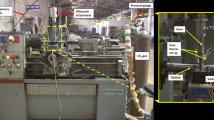Abstract
This paper compares finite element model (FEM) simulations with experimental and analytical findings concerning precision radial turning of AISI D2 steel. FEM machining simulation employs a Lagrangian finite element-based machining model applied to predict cutting and thrust forces, cutting temperature and plastic strain distribution. The results show that the difference between the experimental and simulated cutting force is near 20%, irrespectively of the friction coefficient used in the simulation work (approximately 19.8% for a friction of 0.25% and 18.4% for the Coulomb approach). Concerning the thrust force, differences of about 22.4% when using a friction coefficient of μ = 0.25 and about 56.9% when using the Coulomb friction coefficient (μ = 0.378) were found. The maximum cutting temperature obtained using the analytical model is 494.07°C and the difference between experimentation and simulation methods is 15.2% when using a friction coefficient of 0.25 and when using the Coulomb friction only 3.1%. Regarding the plastic strain, the differences between analytical calculations and FEM simulations (for the presented friction values) suggest that the finite element method is capable of predictions with reasonable precision.
Similar content being viewed by others
References
Trent EM, Wright PK (2000) Metal Cutting. Butterworth-Heinemann, Oxford
Marusich TD, Oriz M (1995) Modelling and simulation of high speed machining. Int J Numer Methods Eng 38:3675–3694 doi:10.1002/nme.1620382108
Bil H, Kilic SE, Tekkaya AE (2004) A comparison of orthogonal cutting data from experiments with three different finite element models. Int J Mach Tools Manuf 44:933–944 doi:10.1016/j.ijmachtools.2004.01.016
Ozel T (2006) The influence of friction models on finite element simulations of machining. Int J Mach Tools Manuf 46:518–530 doi:10.1016/j.ijmachtools.2005.07.001
Ceretti E, Fallbohmer P, Wu WT, Altan T (1996) Application of 2D FEM to chip formation in orthogonal cutting. J Mater Process Technol 59:169–180 doi:10.1016/0924-0136(96)02296-0
Qian L, Mohammad RH (2007) Effect on cutting force in turning hardened tool steels with cubic boron nitride inserts. J Mater Process Technol 191:274–278 doi:10.1016/j.jmatprotec.2007.03.022
Mamalis AG, Horvath M, Branis AS, Manolakos DE (2001) Finite element simulation of chip formation in orthogonal metal cutting. J Mater Process Technol 110:19–27 doi:10.1016/S0924-0136(00)00861-X
Filice L, Micari F, Rizzuti S, Umbrello D (2007) A critical analysis on the friction modelling in orthogonal machining. Int J Mach Tools Manuf 47:709–714 doi:10.1016/j.ijmachtools.2006.05.007
Fang N (2005) Tool-chip friction in machining with a large negative rake angle tool. Wear 258:890–897 doi:10.1016/j.wear.2004.09.047
Sartkulvanich P, Altan T (2005) Effects of flow stress and friction models in finite element simulation of orthogonal cutting—a sensitivity analysis. Mach Sci Technol 9:1–26 doi:10.1081/MST-200051211
Geiger M, Kleiner M, Eckstein R, Tiesler N, Engel U (2001) Microforming Annals. CIRP 50(2):445–462
Zorev N, Wallace P, Boothroyd G (1964) Tool forces and tool-chip friction in orthogonal machining. J Mech Eng Sci 6:422
Özel T, Zeren E (2007) Numerical modelling of meso-scale finish machining with finite edge radius tools. Int J Machining Machinability Mater 2(3/4):451–468
Merchant ME (1945) Mechanics of metal cutting process I—orthogonal cutting and type 2 chip. J Appl Phys 16(5):267–275 doi:10.1063/1.1707586
Boothroyd G, Knight WA (1989) Fundamentals of machining and machine tools, 2nd edn. Marcel Dekker, New York, p 542
Umbrello D, M’Saoubi R, Outeiro J (2007) The influence of Johnson–Cook material constants on finite element simulation of machining of AISI 316L steel. Int J Mach Tools Manuf 47:462–470 doi:10.1016/j.ijmachtools.2006.06.006
Outeiro J (2007) Influence of tool sharpness on the thermal and mechanical phenomena generated during machining operations. Int J Machining Machinability Mater 2(3/4):413–432
Author information
Authors and Affiliations
Corresponding author
Rights and permissions
About this article
Cite this article
Davim, J.P., Maranhão, C., Faria, P. et al. Precision radial turning of AISI D2 steel. Int J Adv Manuf Technol 42, 842–849 (2009). https://doi.org/10.1007/s00170-008-1644-9
Received:
Accepted:
Published:
Issue Date:
DOI: https://doi.org/10.1007/s00170-008-1644-9




